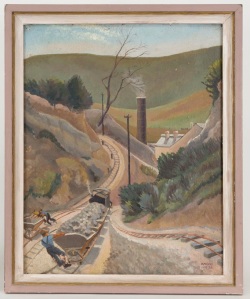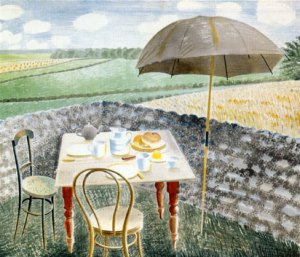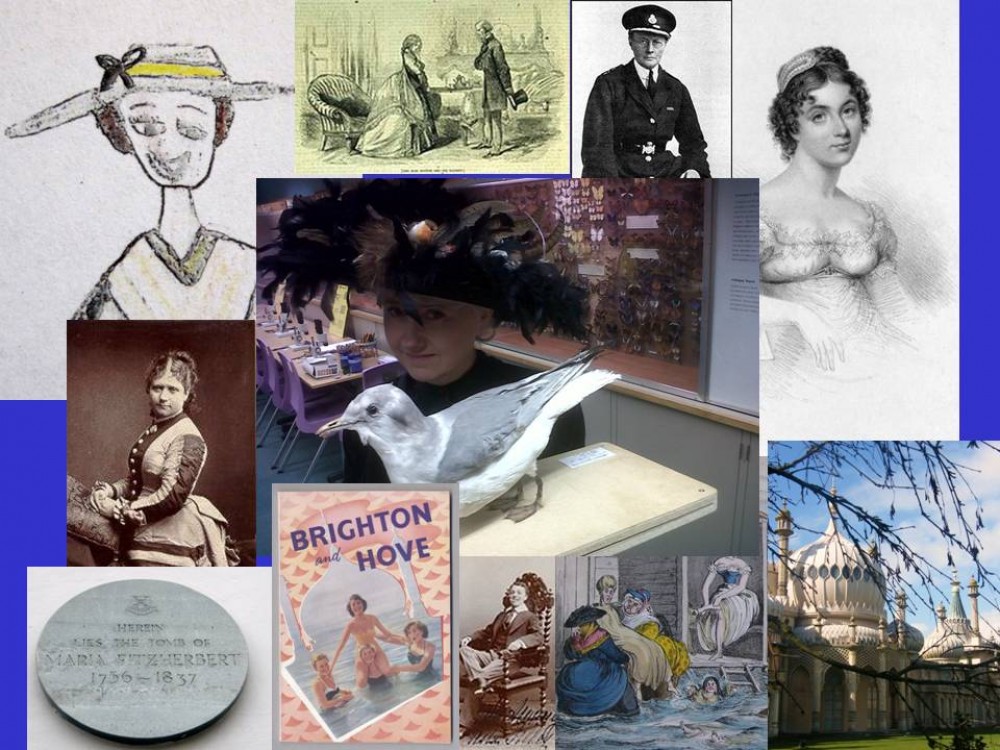I went to the Towner Gallery in Eastbourne last week and was baffled to discover a fantastic female artist who seems to have dropped out of conventional art history. The quite startingly good exhibition, ‘Peggy Angus: Designer, Teacher, Painter’ http://www.townereastbourne.org.uk/exhibition/peggy-angus/ is only on until 21st September and if you are in any way within reach of Eastbourne in the next few days – or even if you aren’t – you really should go. Peggy, although Scottish, worked locally, having bought a shepherd’s cottage called ‘Furlongs’ near Firle. The Sussex countryside is a robust and lively presence in her work, as much a part of her paintings as it was in her friend’s, Eastbourne artist Eric Ravilious, with whom she used to paint. Her life and work and great generosity as an artist and woman deserve much, much more than the brief, potted resume I’m going to give here, but this is her basic story…
Peggy (real name Margaret MacGregor Angus) was born in 1904 in Chile where her father was a railway engineer. Aged 17 and resettled with her family in Muswell Hill, Peggy won a scholarship to the Royal College of Art where her contemporaries numbered Barbara Hepworth, Henry Moore and Edward Bawden. She was taught by Paul Nash, who claimed she was the most obstinate student he’d ever taught. With her brothers and father lost in the First World War it became apparent that, for Peggy, art could never be a luxury but a means to earn money. She trained to be a teacher and in the early 1930s, with one of her teaching jobs bringing her to Eastbourne, she decided to buy ‘Furlongs’, a ramshackle and primitive stone cottage without running water nestling in the South Downs (the story goes that the owner of the house, a local farmer, initially didn’t want to sell so Peggy just set up a tent and camped outside until he changed his mind a few months later). Furlongs was a weekend retreat where she immersed herself in painting lively scenes of the surrounding countryside, all frisky cattle, rat-catchers, threshing, and milking cows ‘I like doing life, things happening,’ she says on a 1980s-filmed interview that runs in the exhibition ‘People doing things.’ Unlike Ravilious whose depictions of the exact same places are haunting, empty of people and isolated, making the landscapes of the South Downs oddly haunting and magical, Peggy’s show a version that is full blooded and immersed in everyday life, warts and all. Peggy and Eric Ravilious, a frequent guest at Furlongs, would go out and paint together. They were both fascinated by the nearby Asham Cement Works (now demolished) and it’s interesting to see both artists’ depictions of this evocative landmark hung next to each other in the gallery, Peggy’s robust and in oil next to the wispy, wintry Ravilious watercolours. This is Peggy’s from 1934.

I am loving imagining the pair of them, lugging their easels over the Downs, perhaps sandwiches or a piece of cake wrapped in paper, the famously jocular Ravilious and Peggy who has been described as ‘eccentric’, ‘opinionated’, ‘difficult’ and ‘a warrior’. Did they argue over their different depictions and styles? Did they laugh?
And here’s one by Ravilious from 1939, ‘Tea at Furlongs’ . Wouldn’t you just like to pull up a chair and pour yourself a cup of tea at that table?

I can’t resist adding this portrait of John Piper completed by Peggy in 1937, now in the National Portrait Gallery.

Those colours and shapes! I stood in front of this in the gallery and it seemed to glow.
Furlongs became something of an alternative Charleston. Not only Ravilious and his wife, the artist and engraver Tirzah Garwood, but also Herbert Read, Serge Chermayeff (co-architect of Bexhill-on-Sea’s De La Warr Pavilion), Brighton artist Percy Horton, John and Myfanwy Piper, painter and Bauhaus professor Laszlo Moholy-Nagy, among others, were frequent guests. The Towner exhibition has recreated one of the rooms – a burst of colour, gorgeous wallpaper, murals and unmatching crockery. Remarkable that the two cradles of artistic talent, just a stone’s throw away from each other, didn’t seem to rub shoulders. I get the impression – I might be wrong – that Furlongs was a whole lot less self-conscious, the ‘Coronation Street’ to Charleston’s ‘Dynasty’ perhaps.
In the title to the exhibition the word ‘painter’ comes last after ‘teacher’ and ‘designer’. Beautiful as her paintings are, it’s really in the latter two that Peggy Angus made her most enduring mark.
Peggy was a fan of William Morris and believed that art and life were inseparable, that art could be found in the everyday and was at its best when it was by the people, for the people, a joy to the maker and user. A visit to the Soviet Union in 1932 with the Art Teachers Conference impressed her with that country’s equality for women and its discussion of art in the context of social history. (This visit impressed her so much she was known as ‘Red Peggy’ afterwards). The impulse to use her talent for the good of society was strong. Not only did she teach, gaining a reputation for coaxing talent from her pupils as well as a lifelong love and respect for the potential of art as a force for good, she also became an incredibly prolific designer, although this seems to have been accidental. Post second world war, when art materials were in short supply, ever practical Peggy turned to potatoes, encouraging her students to experiment with potato printing. One evening FRS ‘Kay’ York, one of the architects involved in the nationwide post-war reconstruction of schools and public buildings, came to dinner, saw the tiles and thought they’d make good murals. Peggy became a prolific and beautiful tile designer, her simple but starkly colourful geometric patterns the perfect way to soften the hard materials and angular lines of the new buildings. .

Her tile work (sadly no longer there) embellished, among many, many other places, the early Heathrow and Gatwick Airports. Below is what you could have enjoyed arriving at Heathrow in 1955.

Peggy would draw the designs of the tiles onto paper and when her daughter suggested hanging some on the wall she had the idea of creating wallpaper. Like the tiles, these were often wonderful geometric patterns often in two shades of the same colour. Ever practical again, she would design them in emulsion paint so clients would be able to mix and match them to their houses with ease.
I took a lot of things away from this exhibition. Mainly – why haven’t I heard about this woman before? Perhaps the circumstances of her life – a single mother with two children meant that, unlike many of her male contemporaries who had the luxury of slipping off to places like Paris to find themselves and experiment for a few years, she had to work hard to earn money. She was never wealthy (apparently she was making the journey to Furlongs from London on the bus with a rucksack until old age). She also had a social conscience which played a part, I think, in her spending a lot of her energy in sharing her talent, nurturing, encouraging, lighting sparks in other people (in her eighties she was running art classes for senior citizens in London). I came across this great article in The Observer http://www.theguardian.com/artanddesign/2014/jul/06/peggy-angus-warrior-painter-designer-tiles-wallpaper in which Rachel Cooke writes “Perhaps, too, her reputation, or lack of one, is connected to the matter of personality. For women of Angus’s generation, professional life was rarely anything less than a struggle: they were required to be tough and, as a result, often
seemed difficult. “She could be really rude to people,” says her daughter, Victoria. “Absolutely foul. She thought it was unfair, her life. She longed for a wife, for someone to do the cooking so she could get on with her work.”
This great generosity and sharing spirit comes out so well in the exhibition. I left with a spring in my step. All those colours, the busyness, the activity in her paintings, the beautiful tiles and wallpaper that would cheer and enrich any house, the fact that, in this artist’s hands, mere potato printing went on to adorn the walls of the world’s busiest airport, the Scottish folk songs from the interviewed film, Peggy’s voice singing out. Working in museums I see a lot of exhibitions but I left this one with a sense that life was a bit brighter.





I am ashamed to admit that, although Bawden and Ravilious are names I know I had never heard of Peggy. It was great to be able to find out so much about her. This entire generation of inter war artists are rightly enjoying a considerable revival. i just wonder too if, as well as links to Charleston, she had any links to Roland Penrose and Lee Miller who had a house in East Sussex as well, somewhere round there. They were visited by Picasso at this house (forgotten its name) in the late 1940s. He was on his way to, or returning from, the infamous Sheffield Peace Congress, sponsored by the Soviet Union and the subject of considerable Cold War political pressure -I think it was closed down. Her Soviet sympathies would have made her a natural part of that artistic/ political network.
LikeLike
Hi Willy, Well, I didn’t know that Picasso visited Sheffield! Thanks for your comments. There really isn’t much about Peggy Angus online. I visited Charleston last weekend for work and asked the guide whether Duncan Grant, Vanessa Bell, et al, had anything to do with Peggy’s establishment which was going at the same time and within a shortish walk away. The guide said no and the reason was probably because the Bloomsbury lot were very inward looking and not that friendly. I was at the Towner, also for work, again last weekend. It was the last day of the Peggy Angus exhibition. Who knows when anyone will gather so many of her works together in the same place again? Everyone coming out of the exhibition was flabbergasted at her brilliance!
LikeLike